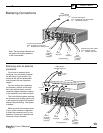
User's Manual
17
APPENDIX
• Check that the interconnect cables
to the ampliÞ er do not have any
broken con nec tions.
Other causes of noise
• Speaker noise may also be caused
by in ter fer ence or noise on your
AC line. Make sure there are no
large ap pli anc es sharing the line,
or halogen lamps or lamps with
dimmer controls.
• Try connecting your system to an-
other AC socket on a sep a rate line.
• Keep power cords away from au-
dio cables.
• Do not place the preampliÞ er di-
rectly on top of the ampliÞ er.
• If the hum is heard from within
the ampliÞ er and not through the
speak ers, this may also be caused
by in ter fer ence on the AC or DC
lines. The power trans form er
may turn this interference into an
audible noise. Internal hum can be
made worse by a shelf or cabinet
resonating, so try moving the am-
pliÞ er to another shelf.
• Try moving your preampliÞ er
further away from your ampliÞ er.
Sensitive preamp circuits may pick
up hum from the am pli Þ er trans-
former’s magnetic Þ eld.
• Try moving your components further
away from the TV, es pe cial ly if
you ever notice the screen has
changed color in the area closest
to the component.
• If you have very high efÞ ciency
speak ers, these may show up
noise which other speakers may
not.
• If you are still having a problem,
re mem ber that Sun Þ re’s dealers
and technical support staff will as-
sist you. Make a list of the things
you have tried.
Poor bass performance
• Make sure that your preamp does
not have the bass level turned
down.
• Many surround preampliÞ ers have
con trols which can direct all the
bass to sub woof ers, or let your
main speakers play the full range.
Make sure that the preampliÞ er
has been correctly set. If you are
not using a subwoofer, set the
speaker options to “Large.”
• Check that the speaker wires have
been connected correctly: Make
sure that the positive of each
speaker connects to a positive out-
put of the ampliÞ er, and the neg-
a tive of each speaker connects to
a neg a tive output. If one speaker is
wired incorrectly, than it will be “out
of phase” with the others, resulting
in poor bass performance.
• If you have connected the ampliÞ er
using the XLR inputs, make sure
that the XLR cables are wired cor-
rectly. If one has the hot and cold
reversed, then this will also cause
a speaker to be out of phase.
Turn-on and turn-off
thumps
• Plug the ampliÞ er into an
unswitched AC outlet, and use the
AUTO-ON feature. This will allow
the ampliÞ er to turn on and off
silently.
Current source outputs not
work ing
• If you are biamping or biwiring,
make sure that the current source
fuses have not blown.
• If these fuses blow often, it is
acceptable to replace with a slo-blo
7 ampere fuse.


















